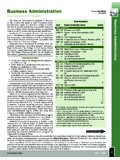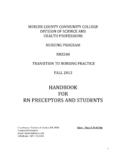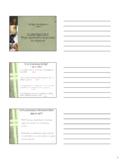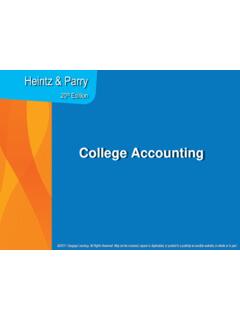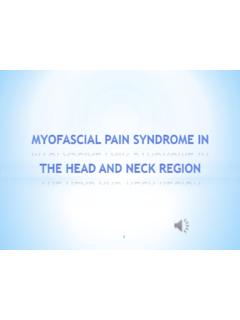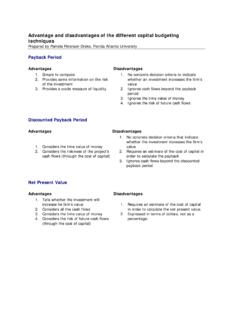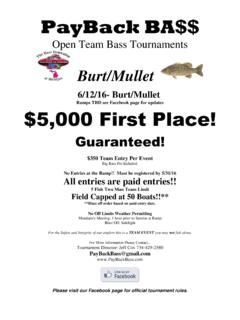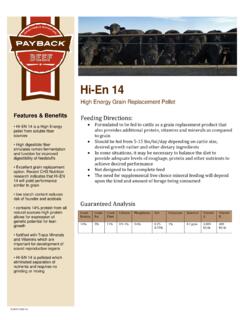Transcription of Financial Accounting and Accounting Standards - MCCC
1 Page 12-1 Page 12-2 Planning for Capital InvestmentsManagerial AccountingFifth EditionWeygandt Kimmel KiesoPage 12-3study capital budgeting evaluation, and explain inputs used in capital the cash payback the net present value the challenges presented by intangible benefits in capital the profitability the benefits of performing a the internal rate of return the annual rate of return 12-4preview of chapter 12 Page 12-5 Corporate capital budgetauthorization for projects are requested from each are screened by a capital budget determine which projects are worthy of of directors approves capital 1 Discuss capital budgeting evaluation, and explain inputs used in capital Capital Budgeting Evaluation ProcessPage 12-6 Page 12-7 For purposes of capital budgeting, estimated cash inflows and outflowsare the preferred Flow InformationSO 1 Discuss capital budgeting evaluation, and explain inputs used in capital Capital Budgeting Evaluation ProcessUltimately, the value of all Financial investments is determined by the value of cash flows received and 12-8 Cash Flow InformationSO 1 Discuss capital budgeting evaluation, and explain inputs used in capital Capital Budgeting Evaluation ProcessIllustration 12-2 Typical cash flows relatingto capital budgetingdecisionsPage 12-9 The capital budgeting decisiondepends availability of among proposed company s basic decision-making risk associated with a particular Flow InformationSO 1 Discuss capital budgeting evaluation process, and explain inputs used in capital Capital Budgeting Evaluation ProcessPage 12-10 Illustrative DataSO 1 Discuss capital budgeting evaluation process, and explain inputs used in capital Capital Budgeting Evaluation ProcessStewart Soup Company is considering an investment of $130,000 in new equipment.
2 Illustration 12-3 Page 12-11 The cash payback techniqueidentifies the time period required to recover the cost of the capital investment from the net annual cash inflow produced by the 2 Describe the cash payback PaybackIllustration 12-4 The cash payback period for Stewart Soup is ..$130,000 / $24,000 = yearsSolution on notes pagePage 12-12 The shorter the payback period, the more attractivethe the case of uneven net annual cash flows, the company determines the cash payback period when the cumulative net cash flows from the investment equal the cost of the 2 Describe the cash payback PaybackPage 12-13 Illustration:Chen Company proposes an investment in a new website that is estimated to cost $300,000. SO 2 Describe the cash payback PaybackIllustration 12-5 Solution on notes pageCash payback should not be the only basis for the capital budgeting decision as it ignores the expected profitability of the 12-14 KRC Paper Corporation is considering adding another machine for the manufacture ofcorrugated cardboard.
3 The machine would cost $900,000. It would have an estimated life of 6 years and no salvage value. The company estimates that annual cash inflows would increase by $400,000 and that annual cash outflows would increase by $190,000. Compute the cash payback 2 Describe the cash payback PaybackSolution on notes pagePage 12-15 QuestionSO 2 Describe the cash payback PaybackA $100,000 investment with a zero scrap value has an 8-year life. Compute the payback period if straight-line depreciation is used and net income is determined to be $20, on notes pageA $100,000 investment with a zero scrap value has an 8-year life. Compute the payback period if straight-line depreciation is used and net income is determined to be $20, 12-16 Discounted cash flowtechnique: Generally recognized as the best approach. Considers both the estimated total cash inflows and the time value of money. Two methods: Net present value. Internal rate of 3 Explain the net present value Present Value MethodPage 12-17 Net Present Value (NPV) method Cash inflows are discounted to their present value and then compared with the capital outlay required by the investment.
4 The interest rate used in discounting is the required minimum rate of return. Proposal is acceptable when NPV is zero or positive. The higher the positive NPV, the more attractive the 3 Explain the net present value Present Value MethodPage 12-18SO 3 Explain the net present value Present Value MethodIllustration 12-6 Net present value decisioncriteriaA proposal is acceptable when net present value is zero or 12-19 Illustration: Stewart Soup Company s annual cash flows are $24,000. If we assume this amount is uniform over the asset s useful life, we can compute the present value of the net annual cash 3 Explain the net present value Present Value MethodEqual Annual Cash FlowsIllustration 12-7 Page 12-20 Illustration: Calculate the net present 3 Explain the net present value Present Value MethodEqual Annual Cash FlowsIllustration 12-8 The proposed capital expenditure is acceptable at a required rate of return of 12% because the net present value is on notes pagePage 12-21 Illustration: Stewart Soup Company expects the same total net cash flows of $240,000 over the life of the investment.
5 Because of a declining market demand for the new product the net annual cash flows are higher in the early years and lower in the later 3 Explain the net present value Present Value MethodUnequal Annual Cash FlowsPage 12-22SO 3 Explain the net present value Present Value MethodUnequal Annual Cash FlowsIllustration 12-9 Computation of present value of unequal annual cash flowsPage 12-23 Illustration: Calculate the net present 3 Explain the net present value Present Value MethodUnequal Annual Cash FlowsIllustration 12-10 The proposed capital expenditure is acceptable at a required rate of return of 12% because the net present value is 12-24In most instances a company uses a required rate of return equal to its cost of capital that is, the rate that it must pay to obtain funds from creditors and rate has two elements: Cost of capital. 3 Explain the net present value Present Value MethodChoosing a Discount RateRate also know as required rate of return.
6 Hurdle rate. cutoff 12-25 Illustration:Stewart Soup used a discount rate of 12%. Suppose this rate does not take into account the risk of the project. A more appropriate rate might be 15%. Net Present Value MethodChoosing a Discount RateIllustration 12-11SO 3 Explain the net present value 12-26 All cash flows come at the end of each year. All cash flows are immediately reinvested in another project that has a similar cash flows can be predicted with Present Value MethodSimplifying AssumptionsSO 3 Explain the net present value 12-27 Compute the net present value of a $260,000 investment with a 10-year life, annual cash inflows of $50,000 and a discount rate of 12%.a.$(9,062).b.$22, $9, $(22,511).QuestionNet Present Value MethodSO 3 Explain the net present value the net present value of a $260,000 investment with a 10-year life, annual cash inflows of $50,000 and a discount rate of 12%.a.$(9,062).b.$22, $9, $(22,511).Solution on notes pagePage 12-28 KRC Paper Corporation is considering adding another machine for the manufacture ofcorrugated cardboard.
7 The machine would cost $900,000. It would have an estimated life of 6 years and no salvage value. The company estimates that annual cash inflows would increase by $400,000 and that annual cash outflows would increase by $190,000. Management has a required rate of return of 9%. Calculate the net present value on this project and discuss whether it should be Present Value MethodSO 3 Explain the net present value 12-29 Calculate the net present value on this project and discuss whether it should be Present Value MethodSO 3 Explain the net present value on notes pagePage 12-30 Net Present Value MethodComprehensive ExampleSO 3 Explain the net present value Taste Foods is considering investing in new equipment to produce fat-free snack 12-12 Investment information for Best TastePage 12-31 Net Present Value MethodComprehensive ExampleSO 3 Explain the net present value the net annual cash 12-13 Solution on notes pagePage 12-32 Net Present Value MethodComprehensive ExampleSO 3 Explain the net present value the net present 12-14 Solution on notes pagePage 12-33 Additional ConsiderationsIntangible BenefitsSO 4 Identify the challenges presented by intangible benefits in capital benefits might include increased
8 Quality, improved safety, or enhanced employee loyalty. To avoid rejecting projectswith intangible net present value ignoring intangible benefits. rough, conservative estimates of the value of the intangible benefits, and incorporate these values into the NPV 12-34 Additional ConsiderationsExample -Berg Company is considering the purchase of a new mechanical 4 Identify the challenges presented by intangible benefits in capital 12-15 Based on the negative net present value of $30,493, the proposed project is not 12-35 Additional ConsiderationsExample -Berg estimates that sales will increase cash inflows by $10,000 annually as a result of an increase in perceived quality. Berg also estimates that annual cost outflows would be reduced by $5,000 as a result of lower warranty claims, reduced injury claims, and missed 4 Illustration 12-16 Berg would accept the 12-36 Page 12-37 Additional ConsiderationsProfitability Index for Mutually Exclusive ProjectsSO 5 Describe the profitability are often mutually often must choose between various positive-NPV projects because of limited to choose the project with the higher 12-38 Additional ConsiderationsProfitability Index for Mutually Exclusive ProjectsSO 5 Describe the profitability :Two mutually exclusive projects, each assumed to have a 10-year life and a 12% discount 12-17 Illustration 12-18 Page 12-39 Additional ConsiderationsProfitability Index for Mutually Exclusive ProjectsSO 5 Describe the profitability.
9 One method of comparing alternative projects is the profitability 12-20 Illustration 12-18 Solution on notes pagePage 12-40 Assume Project A has a present value of net cash inflows of $79,600 and an initial investment of $60,000. Project B has a present value of net cash inflows of $82,500 and an initial investment of $75,000. Assuming the projects are mutually exclusive, which project should management select? A or is not enough data to answer the on notes pageAdditional ConsiderationsSO 5 Describe the profitability Project A has a present value of net cash inflows of $79,600 and an initial investment of $60,000. Project B has a present value of net cash inflows of $82,500 and an initial investment of $75,000. Assuming the projects are mutually exclusive, which project should management select? A or is not enough data to answer the 12-41 Risk AnalysisA simplifying assumption made by many Financial analysts is that projected results are known with certainty.
10 Projected results are only analysis is used to deal with uncertainty. Sensitivity analysis uses a number of outcome estimates to get a sense of the variability among potential ConsiderationsSO 5 Describe the profitability 12-42 Page 12-43 Post-Audit of Investment ProjectsPerforming a post-auditis important. If managers know that their estimates will be compared to actual results they will be more likely to submit reasonable and accurate data when making investment proposals. Provides a formal mechanism to determine whether existing projects should be supported or terminated. Improve future investment ConsiderationsSO 6 Indicate the benefits of performing a 12-44 Page 12-45 Internal Rate of Return MethodDiffers from the net present value method in that it finds the interest yield of the potential investment. Internal rate of return (IRR)-interest rate that will cause the present value of the proposed capital expenditure to equal the present value of the expected net annual cash flows (NPV equal to zero).
